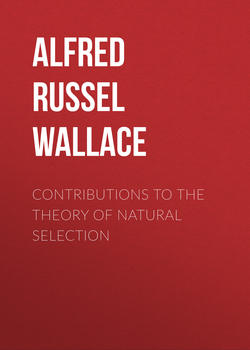Читать книгу Contributions to the Theory of Natural Selection - Alfred Russel Wallace, Alfred Russel Wallace - Страница 28
III.
MIMICRY, AND OTHER PROTECTIVE RESEMBLANCES AMONG ANIMALS
Mimicry
ОглавлениеIt has been long known to entomologists that certain insects bear a strange external resemblance to others belonging to distinct genera, families, or even orders, and with which they have no real affinity whatever. The fact, however, appears to have been generally considered as dependent upon some unknown law of “analogy”—some “system of nature,” or “general plan,” which had guided the Creator in designing the myriads of insect forms, and which we could never hope to understand. In only one case does it appear that the resemblance was thought to be useful, and to have been designed as a means to a definite and intelligible purpose. The flies of the genus Volucella enter the nests of bees to deposit their eggs, so that their larvæ may feed upon the larvæ of the bees, and these flies are each wonderfully like the bee on which it is parasitic. Kirby and Spence believed that this resemblance or “mimicry” was for the express purpose of protecting the flies from the attacks of the bees, and the connection is so evident that it was hardly possible to avoid this conclusion. The resemblance, however, of moths to butterflies or to bees, of beetles to wasps, and of locusts to beetles, has been many times noticed by eminent writers; but scarcely ever till within the last few years does it appear to have been considered that these resemblances had any special purpose, or were of any direct benefit to the insects themselves. In this respect they were looked upon as accidental, as instances of the “curious analogies” in nature which must be wondered at but which could not be explained. Recently, however, these instances have been greatly multiplied; the nature of the resemblances has been more carefully studied, and it has been found that they are often carried out into such details as almost to imply a purpose of deceiving the observer. The phenomena, moreover, have been shown to follow certain definite laws, which again all indicate their dependence on the more general law of the “survival of the fittest,” or “the preservation of favoured races in the struggle for life.” It will, perhaps, be as well here to state what these laws or general conclusions are, and then to give some account of the facts which support them.
The first law is, that in an overwhelming majority of cases of mimicry, the animals (or the groups) which resemble each other inhabit the same country, the same district, and in most cases are to be found together on the very same spot.
The second law is, that these resemblances are not indiscriminate, but are limited to certain groups, which in every case are abundant in species and individuals, and can often be ascertained to have some special protection.
The third law is, that the species which resemble or “mimic” these dominant groups, are comparatively less abundant in individuals, and are often very rare.
These laws will be found to hold good, in all the cases of true mimicry among various classes of animals to which we have now to call the attention of our readers.
